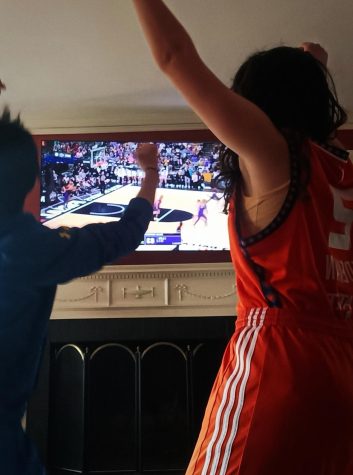Women March Madness
This year’s Women NCAA basketball tournament, won by LSU, has registered more spectators than ever and for the first time in history, the term “March Madness” was used to refer to it, once only reserved to the men’s tournament.
Men helping women overcome gender inequality.
“I didn’t know that, but I’m not surprised. I’m used to women being treated differently than men. I don’t think they have the same opportunities in sports. Women don’t have enough recognition when playing at the same level as men. Sometimes boys don’t take me seriously when we play together. Their attitude changes after they see me play. My friends know me, so they always pick me, but who doesn’t know me, would pick a boy over me.” Said Dynesty Johnson, female basketball player at Hall. She brought an example about the tournament, “Going back to March Madness, the LSU player Angel Reese blocked a shot without her shoe on. After that she said something out of her breath and she got a technical foul, but a man would have been called a tough player for that.”

The tournament was intense and unpredictable, with extremely strong teams playing against each other. We saw at the semifinals some of the best ones: Virginia Tech, South Carolina, Iowa and LSU, with the best players, respectively from each team, Elizabeth Kitley, Aliyah Boston and Zia Cooke, Caitlin Clark, Angel Reese and Alexis Morris.

Women have faced disparities and disadvantages in everyday life, just like in sports, to these days. It’s not a surprise, in fact, that WNBA players earn 41 times less than their male counterparts at the same level. The causes are many and different, ranging from few access opportunities, safety and transportation, society’s judgment, low quality, prices and lack of role models.
Melissa Escobar, member of the wrestling team at Hall, a sport that is known for its male predominance, said that she faces a lot of discrimination in her sport. “Yes, all the time, especially in wrestling. This year we were five and it was the most they had ever been at Hall. The discrimination I got was horrible. My first meet was at Glastonbury. A big boy kept following me and I had to ask my friend for help. A lot of the guys there were really mean and cold. I felt really uncomfortable. Half of my team was really nice to me, but the other half was really pushy. I got treated differently by the coach. He really cared about the varsity. He was really kind but I felt like he wasn’t as present with me.”
Kosei Suganuma, track member at Hall and big basketball fan, gave as his opinion about the topic, “I think that it’s because men’s basketball is more competitive and that is what the audience cares the most about, but I think it’s a very good thing that women’s basketball is becoming popular as well. Boys have more opportunities and more boys definitely tried out for sports like basketball. And the boys who didn’t make it to the actual team, just like me, kept the spirit up, spread the community and gave a lot of support.”

Caleb Lou, volleyball player at Hall, said, “I mean, I think for the most part the opportunity is there. I feel like guys get more dragged into sports than girls just because of the societal stereotype of guys generally being more “sporty”. It’s kind of part of the culture but it’s also kind of assumed too. However, the actual opportunities themselves do exist, but other factors like social interaction or intimidation are different between men and women.”
We can see differences between male and female sports on the screen, but Hall high school doesn’t make an exception, according to many students. However, things can change.
“It has to start from the men. Some men in the NBA are already trying. They have to push and recognize how hard women work.” Said Dynesty Johnson.
“We should encourage people to show up to the girls’ games, spread the community, invite people to watch the games and support the teams.” Said Kosei Suganuma.







